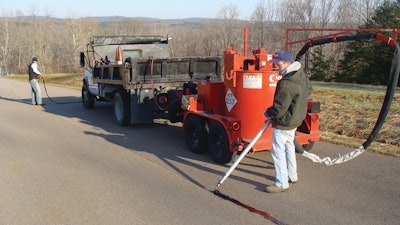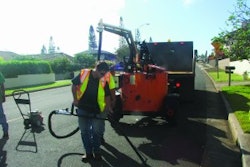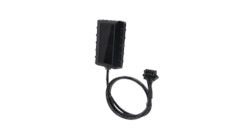
The first part of a good pavement program starts with a survey of the current pavement condition. The first part of the survey is identifying various pavement distresses. The first distress that will develop in new pavement is cracking. Cracking is generally identified in four forms:
- Longitudinal and transverse
- Block (thermal)
- Crescent (cracking along the edge of the pavement)
- Reflective (in slurry seal and overlays)
Longitudinal, transverse and block cracking are generally the first cracking distresses to develop in pavement. Longitudinal and transverse cracking develop from paving joints separating, shrinkage of the pavement, and base or subgrade movement. Block cracking is a result of thermal or temperature changes and fluctuations. The pavement will crack from expansion and contraction and oxidation, and the cracking is in the form of squares or blocks.
Crescent cracking is a result of failure along the edge of an unconfined street, road, or parking lot. This type of crack is caused from movement of the paved surface outward when exposed to a loading.
Reflective cracking develops from below a new surface (such as chip seal, slurry seal, or overlay) from existing cracking. As the older pavement expands and contracts the cracking will reflect through the new surface. A fabric (stress-absorbing membrane) can be used to retard the rate of reflective cracking, but cracking will eventually reflect through.
Once cracking begins, other structural distresses will begin to develop. All cracks allow water to infiltrate (percolate) through the paved surface and saturate the base course and subgrade below the pavement. Once the base or subgrade is saturated, structural failures can begin to develop.
That is why it is very important that cracks are sealed whenever they have an opening of ¼ inch or more. This recommended crack opening width was determined by studies conducted by several research agencies; it was found that cracking with an opening of ¼ inch or more went all the way through to the bottom of a 2-inch to 3-inch paved surface. Also, you need a minimum of a ¼-inch opening to get proper penetration of crack sealant. For less than a ¼-inch opening you are only wasting maintenance dollars because the crack seal material is not penetrating the crack properly and is only spread on the surface.
Sealcoating will fill cracks less than ¼ inch wide and provide the protection needed. Smaller or thinner cracks in openings sometimes do not go all the way through the paved surface. As the pavement oxidizes and shrinks, smaller cracks will develop into larger cracks, and new cracks will develop.
Also, the pavement next to concrete curbs and valley gutters (concrete swales) will shrink and separate from each other. These openings, too, will need to be cracksealed when they reach a ¼ inch opening, since curbs and valley gutters are exposed to more water than the actual paved surface. Separation of the pavement from the curbs and gutters generally occurs after five-plus years from installation.
An elastomeric material, which will expand and contract with the pavement from exposure to temperature changes, should be used as the crackseal material. It should have a high softening point to eliminate tracking problems on sidewalks, pool areas, and interior carpets. Different geographical areas will require material with different softening points (colder climates vs. desert climates). Several types and grades of crackseal materials are available and may be applied as cold-poured or hot-poured.
A crack must be properly prepared before the sealer is applied. Proper preparation of the crack will allow proper adherence of the material on either side of the crack. If a crack less than ¼ inch wide is scheduled to be cracksealed it should be routed to open the crack to ¼ inch. Routing is an expensive task and, therefore, not always recommended for parking lots and home owner association streets. [Some studies, however, have found that creating reservoirs through routing can result in longer-lasting repairs, making the additional expense of routing worthwhile.-Ed.]
Whether routing is used or not the crack must be cleaned before material is introduced. Compressed air should be used to blow out debris and any loose particles. Cracks should then be sealed with a crackseal material (hot- or cold-applied) and banded by “V”-shaped squeegee after application. A hand squeegee or a stationary foot on the pour pot can be used to band the crackseal material on either side of the crack. This banding completes the cracksealing process and aids in sealing water from entering the crack.
Crackseal is a preventive maintenance application to seal cracks with a surface opening of ¼ inch or more. Cracksealing is applied into the crack after it has been cleaned of all sand, dirt, debris and all noncompressible materials. Also, the crack must be dry and free of moisture prior to applying the sealant,
The cracksealing material can be either cold poured or hot poured. Hot-poured sealant is applied to the cracks from pour pots or from an onsite hot pot, through a hose and wand applicator under pressure. Cold-poured sealant is applied by pour pot only. Material applied with the wand and under pressure is designed to penetrate into the crack; this is an excellent way to apply the cracksealing material. However, the tip of the wand must be placed at the entry of the crack in order to be applied correctly and to get the maximum benefit of the application.
It is not recommended or acceptable for the material to be “shot” at the crack opening from a distance because the material will not have the proper, recommended, and specified flow entry. Also, “shooting” material creates a messy application and increases the cost.
Pour pot application is a gravity installation meaning the material gets the penetration needed from gravity flow and from the pressure applied to the pour pot by the operator. Pour pot application is an acceptable method of sealing cracks. However, the pour pot must have the proper application foot that is in contact with the surface, forcing material into the crack and banding the material to both sides of the crack. The cracksealant must be banded or spread on the pavement next to the crack and cover a width of 1/3 inch to 1 inch on both sides of the crack.
Be Aware of Curing Characteristics
Cracksealant will leave a solid black band where it is installed and this will be permanently in place. When applied prior to sealcoating the cracksealant will be visible within hours after sealing. After the sealcoat wears off the cracksealant will still be present and very visible. Cracksealant will shadow through slurry seals and chip seals but it will not be as visible as it is with sealcoats. There is very little or no apparent appearance of cracksealant with overlays, especially when a fabric interlayer is installed
Cracksealant has to have a specified minimum softening point that is compatible to the geographical area where it is installed, which also relates to the maximum highest daily temperature. Highest daily temperature directly affects the ground temperature, which, in turn, affects the softening of crackseal materials.
When a lower-grade cracksealant, with a lower softening point, is installed in a climate where the ground and ambient (air) temperature can exceed the designed softening point of the material, it becomes liquid and can be tracked on concrete, walks, and pool decks and inside buildings.
There are several grades of cracksealant designed for specific climate areas and conditions. Should ambient and ground temperatures cause the crackseal material to soften and the temperatures stay high consistently, it is recommended to apply a blotter material on the cracksealant as soon as it is applied. This blotter material is usually sand or Portland cement. The blotter material aids in preventing pickup by vehicles or pedestrians until the sealant has ample time to setup and cure.
Because cracksealant becomes soft and pliable when hot, striping sealant may flake off or disappear when applied over cracksealant. This is caused by the elastic characteristics of the cracksealant as it moves with the expansion and contractor of the asphalt pavement.
Excerpted from Guide to Pavement Maintenance by Thomas McDonald and Patrick McDonald, Pavement Maintenance Information Source, 18521 E. Queen Creek Road, Suite 105-435, Queen Creek, AZ 85242; www.pavementmaint.com. For information on the book e-mail them at [email protected].


















